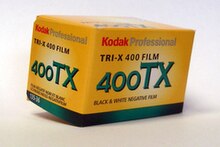Kodak Tri-X
| Tri-X | |
|---|---|
 |
|
| Maker | Kodak |
| Speed | 400/27° |
| Type | B&W print |
| Process | Gelatin-silver |
| Format | 35 mm, 120 |
| Application | General |
| Tri-X Professional | |
|---|---|
| Maker | Kodak |
| Speed | 320/26° |
| Type | B&W print |
| Process | Gelatin-silver |
| Format | sheets |
| Application | General |
Tri-X is a black-and-white photographic film produced by Eastman Kodak Company and remains the world's best selling black and white film. It is appreciated for its wide exposure latitude and classic grain structure. The combination of smaller 35mm cameras and high speed Tri-X film was transformative for photojournalism.
Introduced around 1940 in sheets rated at ASA daylight 200 and tungsten 160, it was one of Kodak's first high-speed (for the time) black-and-white films. Tri-X was released in 35mm and 120 in 1954. Currently it is available in two speeds, ISO 320/26° (320TXP) and 400/27° (400TX). Tri-X 400 is the more common of the two, available in 24- and 36-exposure rolls of 35 mm and rolls of 120 as well as 50 and 100 ft bulk rolls of 35mm. Tri-X 320 is available in 4×5", 5×7", and 8×10" sheets.
Tri-X 400 is usually rated at ISO 400 when processed in standard developers and remains among the fastest black-and-white films today. Push processing Tri-X to a higher "exposure index" of EI 800 in a standard developer yields very good results, while further pushing to EI 1600 requires more sophisticated processing. A popular method for pushing Tri-X film is using highly diluted developers with little or no agitation and extended development times. This method which is referred to as "stand" or "semi-stand" development, can allow the film to be pushed to speeds up to EI 3200 or 6400.
In 2004 Kodak celebrated 50 years of Tri-X's introduction on November 1, 1954 in 35 and 120 formats.
Tri-X panchromatic film was once one of the most popular films used by photojournalists and many amateurs. It was manufactured by Eastman Kodak in the US, Kodak Canada, and Kodak Ltd in the UK. Kodak data-sheets once recommended different processing times depending on where the film was manufactured. Its sales declined in the 1970s and 1980s due to the falling price and increasing popularity of color film. Since the advent of digital photography, Tri-X has all but fallen out of use in newspaper journalism, though it remains popular in documentary journalism.
...
Wikipedia
